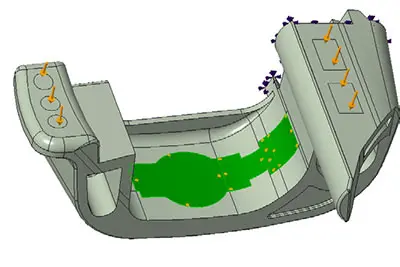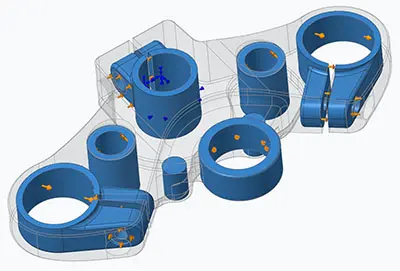October 3, 2023
The Evolution of CAD Mechanical Engineering
READ TIME: 3.8 MINS
Computer-aided design (CAD) has revolutionized the world of mechanical engineering. But what exactly is CAD, and how does it fit into the realm of mechanical engineering? Buckle up as we delve into the intricacies of this powerful tool that has shaped the way engineers design and innovate. Get ready to unlock the secrets behind CAD’s impact and indispensable role in the field.
What is CAD in Mechanical Engineering?
Computer-aided design in mechanical engineering, or CAD in mechanical engineering, refers to utilizing specialized software to assist engineers in designing and analyzing mechanical components and systems. This technology enables the creation of detailed 3D models and 2D drawings, serving as a blueprint for manufacturing processes. With CAD, mechanical engineers can visualize, simulate, and analyze the performance of a design before it’s physically manufactured, ensuring optimal functionality and quality. The integration of CAD mechanical engineering has streamlined design processes, reduced errors, and enhanced collaboration among professionals.

Historical Context
Originating in the 1960s, CAD became more accessible to professionals in the 1990s with tools like PTC Creo and Siemens NX. Before the digital age, engineers relied on manual drafting techniques, which were time-consuming and prone to errors. With CAD, designs could be created, modified, and analyzed quickly and accurately.
Applications of CAD Mechanical Engineering
Optimizing your products to outperform competitors gives you a competitive advantage. Balancing lightweight design with necessary strength is crucial. While humans excel at meeting requirements, engineers can leverage CAD in mechanical engineering to rapidly iterate and discover the optimal design. Let’s explore a few examples:
PRECISELY MEASURE VARIOUS PARAMETERS
Behavioral modeling allows us to create features that precisely measure various parameters. We can effectively drive these measurements toward desired values by conducting studies within our models. This is achieved by modifying model dimensions and optimizing our goals. Notably, any changes made to the model geometry automatically trigger recalculations of measurements and studies, ensuring our designs meet requirements and are simultaneously optimized.

VALIDATION AND OPTIMIZATION
Simulation analysis plays a crucial role in validating and optimizing our designs. It provides valuable insights into how the model performs under specific loads and constraints, revealing stress, displacement, temperature, modal frequencies, cycles to failure, and other essential quantities. With this information, we can calculate the optimal values for model dimensions under various load cases.
Consider a few examples of how these technologies seamlessly integrate into the Creo environment. Creo Simulate is directly built into the Creo Parametric platform, eliminating the need for model exports. Additionally, Creo Simulation Live allows real-time analysis to be performed alongside the design process, ensuring efficient and continuous improvement.
PREDICT AND PREVENT DESIGN FLAWS
Generative design technologies, such as topology optimization, offer incredible potential for crafting geometry that meets precise requirements while minimizing material usage. Although primarily suited for 3D printing applications, these tools can also inspire ingenious designs for traditionally manufactured parts. Read more about the best generative design software of 2022.

Visit this page on your mobile device to view the model in your space, or click below to see it in action!
REVIEW, PLAN AND COLLABORATE
Today, CAD mechanical engineers can rapidly publish designs to augmented reality (AR) servers. Using tools like Vuforia Engine or KeyShot Web, engineers can view their models overlaid in the real world using mobile devices and headsets within minutes. This transformative capability offers unprecedented insight into how customers respond to and interact with products in their potential operating environments.
AR goes beyond visualization; it can also facilitate design reviews, aid in manufacturing planning, and provide invaluable support to technicians during builds. This level of product insight, coupled with real-world superposition and supplementary information, has never been accessible to the production industry before. And we are only scratching the surface of its immense potential.
With behavioral modeling, simulation analysis, generative design, and augmented reality (AR), CAD mechanical engineering gives users a powerful toolkit for creating exceptional products.

The Impact of CAD Mechanical Engineering
Increased Productivity: Automated tools and templates expedite the design process.
Reduced Errors: CAD tools alert professionals to design flaws, ensuring high-quality outputs.
Enhanced Communication: 3D models and visualizations offer a clearer understanding of the design, improving stakeholder communication.
The Future of CAD Mechanical Engineering
CAD, or Computer-Aided Design, has revolutionized the field of mechanical engineering, empowering professionals to boost productivity, accuracy, and innovation. This dynamic technology serves as a testament to the power of technological advancements. As the design and manufacturing world continues to evolve, CAD mechanical engineering plays a pivotal role in shaping the future, promising exciting opportunities for engineers and designers alike.
Ready to get started designing the products of the future? Learn more about PTC Creo 10 or start your 30-day free trial!
Links to Other Pages
- Features of CAD Software – The 9 Essentials: Explore the nine essential features every CAD software should have to enhance your design process.
- Creo Parametric: Learn about the powerful capabilities of Creo Parametric for parametric 3D CAD design.
- Best Generative Design Software – Top Choice: Find out which generative design software is the top choice for engineers and designers.
- Exploring 3D CAD Rendering For Engineers And Manufacturers: Delve into 3D CAD rendering and its applications for engineers and manufacturers.
- AI CAD Design Revolutionizes Digital Engineering: Discover how AI-driven CAD design is revolutionizing digital engineering and transforming the industry.
TriStar Digital Thread Solutions welcomes questions. Feel free to CONTACT US if you can’t find what you’re looking for, or call us at 800-800-1714






Leave A Comment